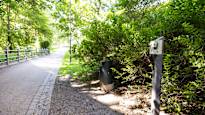Helsinki has taken a unique approach to safeguarding its city parks from the harmful effects of pet urine by constructing designated dog toilets. These dog toilets, strategically placed along popular walking routes in densely populated areas, serve as a solution to the problem of pet waste affecting plant life in urban green spaces. The latest addition to these pet-friendly facilities is in the newly renovated Linnankoskenpuisto in Töölö.
“A dog toilet corner is always a positive addition to a park. The park remains in better condition and more pleasant for all users compared to areas without designated pet waste facilities,”
notes Satu Talvio, an environmental specialist with the City of Helsinki. The composition of these dog toilets typically includes a sand-based surface that is easily replaceable, a post suitable for urination, a sign indicating the area for dogs, and a trash bin. The sand base can be readily swapped out to maintain hygiene, while the post is usually made from recycled plastic.
“Dog urine is acidic, very salty, and rich in nutrients. In large quantities, it can be toxic to plants. For instance, perennial beds suffer if their growing medium becomes too saline. Protecting flower beds in parks can be achieved by constructing protective barriers around them,”
explains Satu Talvio. She emphasizes that while the urine from individual dogs may not pose a significant threat, the accumulation of waste in concentrated areas on densely populated residential blocks can be detrimental to plant life.
Over the past decade, Helsinki has been progressively installing dog toilets in parks located within urban neighborhoods, with the initial facilities appearing in the Kallio district and expanding to areas like Jätkäsaari and Kalasatama as the city grows. With an estimated 30,000 dogs in Helsinki, these dog toilets have been proven effective through soil samples taken from them. Nitrogen levels on the busiest dog-walking routes in central Helsinki’s green spaces can be nearly ten times higher than in similar areas in sparsely populated regions.
“Dogs typically mark their territory as soon as they enter a park. It would be beneficial to have dog toilets located within the park as well, as dogs communicate through marking,”
adds Satu Talvio. Animal trainer Lina Nikula suggests that dogs can be trained to relieve themselves in specific areas by providing ample designated spots throughout the city. By associating a cue word with the desired behavior and praising the dog when it complies, canines can quickly learn the significance of the word.
“However, this method does not guarantee that a dog will not relieve itself elsewhere. It’s crucial never to scold or punish a dog for marking or urinating in an undesired location. Allowing dogs to sniff around while outdoors is also important,”
advises Lina Nikula. In urban environments, where there is a greater concentration of dogs, the need for dogs to communicate through marking increases significantly due to the presence of numerous animals.
For plant enthusiasts and dog owners alike, there are practical tips to minimize the impact of pet urine on greenery. Plants with shallow roots, such as small shrubs, are more susceptible to damage from dog urine compared to larger trees. Evergreen plants are particularly sensitive to dog urine, so it’s advisable to avoid the ends of hedge rows where dogs tend to mark more frequently. Some parks may provide small designated urination points or rocks at the edge of shrubbery for dogs to use, which can be utilized effectively.
When planning your outdoor activities with your furry companion, consider the direction of your walking route. Start with open spaces at the beginning of your walk and conclude with more densely planted areas. It’s also recommended to flush the urine with water, as excessive dog urine can cause patchy spots on lawns. A suitable amount of water to use on city walks could be a bottle, while at home, a watering can might be sufficient. Especially during hot summer days, diluting the urine with water can be beneficial as it prevents it from drying up on surfaces.
The initiative taken by Helsinki to introduce dog toilets in urban parks not only addresses the issue of pet waste management but also contributes to the overall well-being of the green spaces within the city. By educating pet owners on responsible pet care practices and providing designated areas for dogs to relieve themselves, Helsinki is setting an example for sustainable urban living that promotes harmony between pet ownership and environmental preservation.

